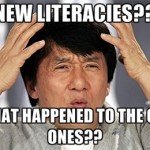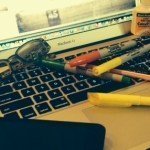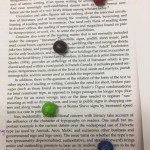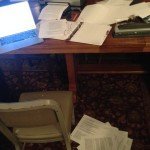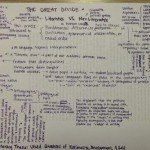
Featured Curators: Isaiah Hamilton & Kaitlynn Price
This week in Literacy Studies: A Multilingual Kaleidoscope. We took a look into the field of Critical Literacy Education as well as a peak into the world of Bi/multi/translingual literacies. (Spoilers ahead)
The first of our chapters, “Critical Literacy Education,” provides a meta analysis in order to mark the upward trend in academic articles being published on critical literacy and to point out the shift from articles being written about classroom-based observations to a focus on using empirical data. The chapter also gives a historical overview of the field from 1990-2012. Critical literacy concerns itself with “using technologies . . . to analyze, critique, and redesign structures that influence daily life” (62). When individuals are presented with tools to analyze the world in which they live, they are empowered to do something to alter that world—critical literacy seeks to do with words. Rebecca Rogers and Katherine O’Daniels’ chapter demonstrates this through the work of Paulo Freire, who advocates for the “reading of the word and the world” (63). Freire encourages his adult literacy learners in Brazil to read the world by seeking out the causes of oppression in their community through the naming of specific instances in their lives when they were exploited. Once their words have been articulated and displayed in front of them, they are more easily able to learn ways to combat the continuation of their circumstances. This example shows the importance of the research being done in order to help educators better prepare their students to face the inequalities that they will come into contact with.
The second of the two chapters, “Bi/multilingual Literacies in Literacy Studies,” first provides the historical context surrounding the problematization of monolingual ideologies in the field that emerged along side the critiquing of the autonomous model. The chapter later spends a large section discussing an example of translingual literacy in a Hong Kong newspaper. To explain in brief: In 1997 China, the official policy of language education was to teach writing in only Standard Written Chinese (SWC) and English, students are told and taught that Cantonese is dialect, and “Cantonese-specific words (Cantoneisms) are systematically banned and cleansed in students’ writing outputs in schools” (83). However, humans tend to use language however they please when no one is hovering over them, waiting to make corrections, and the chapter shows what happens when people who are well versed in multiple languages fully utilize their knowledge and linguistic experience. In a Hong Kong newspaper, the author, knowing their audience, makes use of SWC, English, and Cantoneisms to make a rich, fluid form of communication. In his Google+ post, Shane shows the value of a historical example such as this one: “this research highlights a flawed but general notion that languages can remain definable (and constructable) at the macro scale. The reality is that the actual communication is a mixing of ‘dialects’ with SWC and even English. This characteristic largely nullifies arguments for standardizing writing to produce greater comprehension among the populace because people don’t really use the ‘standard’ language put forth.”
Before moving on to the discussions held in class, I feel that I need to state that I have severely truncated these two chapters because, as Neesa says in her Google+ post: “Somehow, this text is able to fit encyclopedic swaths of information into the smallest of spaces—if this book were a person, it would be made of pure muscle.”
In light of the articles we had read, the class discussed our impressions of literacy practices, specifically looking at the question: Why do we care about what and how we consume? To better address this question, we broke it down into smaller categories. First, we asked: why do we read? This is actually quite a difficult question as it’s hard to pinpoint the reason, and everyone has a different motivation. Some said they read for entertainment and others said to stay connected to the world. Personally, much like exercise, I dislike the actual process of reading, but I endure it for all the great after effects—I enjoy having read much more than reading.
Next we moved on to a question that generated quite a lot of discussion: Why do we care what people read? One the first answers given was the social aspect that reading can provide. If someone has read the same thing you have, you can engage with that person around the text you have in common. In that same vein, a text has cultural impact—some works provide a key to understanding other works, and some texts are so influential that having read them provides insight to the moves other texts might make. We also discussed the “fast-food effect” that some texts provide. It was offered, “When I’m reading something like People it feels like I’m putting my brain to sleep, and that feels good.” To which another pointed out, “There’s a difference between something that’s ‘fluff’ and dangerous.” A gossip magazine might not be actively harmful, but that doesn’t mean that there are no publications that could be harmful if mishandled.
The last question asked was whether or not it’s necessary for everyone to read. This was answered quite well with a wonderful quote from one of my colleagues (I apologize for not making note of who it was): “Fiction teaches empathy, so if you’re not reading, you need to be learning that elsewhere.” It is a point often overlooked that reading is deeply social. A person can learn to interact with others respectfully by being around other people, but that limits them to learning about those in their immediate surroundings. Through reading, that same person can learn to empathize with cultures worlds away that they may never interact with in person. In our world that becomes more and more connected at an ever-increasing rate, how much more important will such skills be in the future? Reading, especially if practices like critical literacy are taught, can provide that understanding.
 Isaiah Hamilton is in his first semester of graduate school. After working full time in a retirement home as a dishwasher for 5 years, he decided that he had been doing that long enough and went to Butte College to see what he could do. He took an English class and decided realized that he liked to think about things and he wanted to teach. He transferred to UC Irvine in 2016, graduated in 2018, and started on his MA English on the Literature track this past January. He has yet to decide on a thesis topic.
Isaiah Hamilton is in his first semester of graduate school. After working full time in a retirement home as a dishwasher for 5 years, he decided that he had been doing that long enough and went to Butte College to see what he could do. He took an English class and decided realized that he liked to think about things and he wanted to teach. He transferred to UC Irvine in 2016, graduated in 2018, and started on his MA English on the Literature track this past January. He has yet to decide on a thesis topic.
On the week of February 18th, the class was left with even more questions moving forward in our quest to find the answer to the inevitable question: What is literacy? Continuing with our reading of The Routledge Handbook of Literacy Studies, Chapters 4 and 5 finish off the final pieces of the puzzle as to what makes up the foundations of literacy studies.
In looking at Chapter 4: “Critical Literacy Education,” the primary focus was based on an overall view of the field of critical literacy. As such, Rebecca Rogers and Katherine O’Daniels define critical literacy as: “the practice of using technologies (from print to digital technologies) to analyze, critique, and redesign structures that influence daily life” (264). One of the many approaches to critical literacy was that of Paulo Freire’s coined phrase of “reading the word and the world” (266). In this concept, exploited experiences that are written down unearth the truths of social problems. When looking at the various scholarship studies conducted in regards to critical literacy, the three themes presented in the 2012 studies proved to be the areas of active inquiry. These themes included: Critical Literacies as a Bridge to Access and Transform Codes of Power, Critical Literacy as Social Justice, and Critical Literacy as Dialogic Engagement. The authors at the end of this section claimed that the field of critical literacy “should continually reconsider definitions of critical literacy” (301) especially when looked at through a world lens across various forums (time, place, etc.)
The focus of Chapter 5 turned many heads as the concept of bi and multilingual studies was pursued. Authors Angel M.Y. Lin and David C.S. Li indicate that the various terms when discussing bi and multilingual literacies can be summed up into the rise of the most recent term of “translingual practice” (325). The two concepts of focus in this section were: (1) for the authors to look at the early theoretical developments of the terms and apply them to recent work that has emerged to break through the one language concept that governs our understanding of literacy, and (2) for the authors to discuss how the new literacy practices have expressed many social viewpoints of literacy practices. Their area of research was focused on a case in Hong Kong, where Cantonese, English and Chinese literacies have been mixed together for the last century. In the conclusion to the study, the author’s claimed that there is an “interesting contrast between, on the one hand, official school literacy norms and standardness….and on the other hand, non-school literacy practices in local newspapers and magazines where such norms and standardness are patently ignored” (349).
After engaging with both chapters, our class had many overlapping themes that came up in our Google community posts. A majority of the class referenced from Chapter 4 Paulo Freire’s concept of “reading the word and the world.” According to Charlotte in her post about Freire’s concept: “having language to describe the ways in which certain groups are oppressed is a necessary step in social justice and moving forward.” Could not agree with her more. Also, there were many references to the three themes in the areas of active inquiry scholarship. I was intrigued by the way that most people interacted with the themes through their own experiences. Both Hannah D. and Hannah E. expressed the same reaction with the quote by Aukerman: “students are often adopting the teacher’s lens. The question, then, is how to create contexts’ where teachers’ knowledge and authority are also the subject of critique.” This concept that they both brought up led them to this “oh sh**” moment when as teachers, they started to recognize that there is the adoption of the teacher lens that students are prone to acquire since the class is designed around the teacher’s aesthetics.
Coming back to the class as a whole for the night, the responses on the Google posts indicated two primary questions of observation: What does literacy do for us…and Why do we read? The class began to state answers such as: “to educate yourself, to escape reality, to stay informed/connected with current events of the world, it is a shared cultural aspect in understanding one another, and the act of participating in a culture were literature still matters/has an impact still (i.e. Shakespeare). All of these concepts boiled down to one claim that the class agreed upon: literacy is attached to identity. After looking with the five foundations of literacy studies, the class engaged in an open discussion of what we now know of literacy studies so far. The list constituted as follows: literacy contains both social and cultural aspects, it is something that people “do”, language is inherited (genetically or socially), critical literacy studies allows for safe questioning of ideas and concepts, and literacy cannot be officially defined because it is constantly changing.
Still, after all of this introduction too literacy studies, there seems to be some looming questions as to what surrounds literacy studies. To summarize this concept up, I will reiterate the same questions that Keaton posed at the end of his post: “Is it just a practice to share literacies and languages with an attention to power structures? Is it the process of being critical to literacies by using frameworks like the one Jank’s proposes, examining concepts of domination, access, diversity, and design in discourses and literacies? Is it something else altogether?”
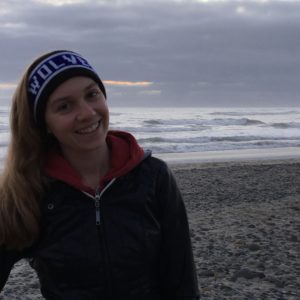 Kaitlynn Price is currently in her second semester as a grad student. She completed her BA degree at Chico State in 2017 and came back to pursue her MA in English, Literature in 2018. She is currently in the works of her thesis–The Victorian Governess: The Role of Social Anxieties (totally a working title). She plans on identifying how the governess is portrayed in books compared to real life, as well as how her role created social anxieties in her social status in and out of the family circle. She enjoys running, golf, journaling, reading, listening to music, binge watching Star Wars and being with friends and family.
Kaitlynn Price is currently in her second semester as a grad student. She completed her BA degree at Chico State in 2017 and came back to pursue her MA in English, Literature in 2018. She is currently in the works of her thesis–The Victorian Governess: The Role of Social Anxieties (totally a working title). She plans on identifying how the governess is portrayed in books compared to real life, as well as how her role created social anxieties in her social status in and out of the family circle. She enjoys running, golf, journaling, reading, listening to music, binge watching Star Wars and being with friends and family.
